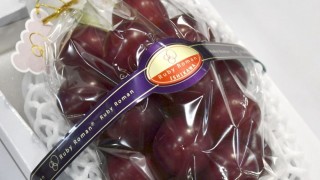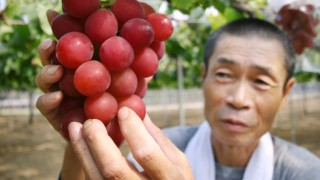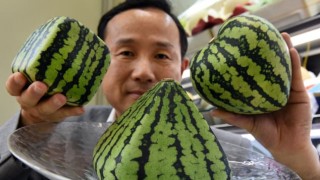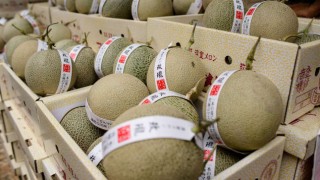Loading
Search
▼ This Bunch Of Grapes Just Sold For $11,000 In Japan
- Category:Other
(CNN) — Visitors to a hot spring in central Japan will soon be able to snack on $460 grapes, or rather, grape.
That's after the manager of a chain of hot spring hotels in Ishikawa Prefecture, on the northern coast of the main Honshu island, became the winning bidder for a bunch of Ruby Roman grapes at an auction in Kanazawa on Tuesday.
Takashi Hosokawa will pay 1.2 million yen, or around $11,000, for the 24 plump, deep red grapes prized for their juiciness, high sugar content and low acidity. It's the most expensive bunch since the breed came to market 12 years ago, the auctioneers said.
"We offered 1.2 million yen to mark the 12 years and to celebrate Reiwa's first auction," Hosokawa told reporters, referring to the country's new era, which began in May with the coronation of Emperor Naruhito.
"We would like to convey to our customers our exhilaration when we held the (box of) grapes."
Ruby Red grapes were developed in Ishikawa and first came to market in 2008. They've been hugely popular ever since, with only a select number being sold to keep demand and exclusivity levels high. Around 26,000 will be sold this year, though not all will go for the record prices seen at the Kanazawa auction.
That's after the manager of a chain of hot spring hotels in Ishikawa Prefecture, on the northern coast of the main Honshu island, became the winning bidder for a bunch of Ruby Roman grapes at an auction in Kanazawa on Tuesday.
Takashi Hosokawa will pay 1.2 million yen, or around $11,000, for the 24 plump, deep red grapes prized for their juiciness, high sugar content and low acidity. It's the most expensive bunch since the breed came to market 12 years ago, the auctioneers said.
"We offered 1.2 million yen to mark the 12 years and to celebrate Reiwa's first auction," Hosokawa told reporters, referring to the country's new era, which began in May with the coronation of Emperor Naruhito.
"We would like to convey to our customers our exhilaration when we held the (box of) grapes."
Ruby Red grapes were developed in Ishikawa and first came to market in 2008. They've been hugely popular ever since, with only a select number being sold to keep demand and exclusivity levels high. Around 26,000 will be sold this year, though not all will go for the record prices seen at the Kanazawa auction.
Expensive fruit, prized for their appearance and taste, are a key luxury good in Japan, bought as gifts or for promotional purposes by businesses.
"People purchase these expensive fruits to demonstrate how special their gifts are to the recipients, for special occasions or for someone socially important, like your boss," Soyeon Shim, dean of the School of Human Ecology at the University of Wisconsin-Madison, told CNN in 2017.
Ruby Roman grapes, grown in central Japan, are among the most expensive in the world, prized for their sweetness and low acidity.
In Japan, there's a specialty fruit craze sweeping the nation, from square watermelons to grapes the size of Ping-Pong balls. Still, the crown jewel of the luxury fruit basket is the white strawberry, bred to be a whole lot bigger and a whole lot sweeter than its classic red counterpart.
These can often be uniquely shaped or colored fruit, which are painstakingly cultivated or forced to grow in a specific way, such as square watermelons, heart-shaped strawberries or the albino White Jewel strawberries grown in Karatsu, on Japan's southern Kyushu Island.
"People purchase these expensive fruits to demonstrate how special their gifts are to the recipients, for special occasions or for someone socially important, like your boss," Soyeon Shim, dean of the School of Human Ecology at the University of Wisconsin-Madison, told CNN in 2017.
Ruby Roman grapes, grown in central Japan, are among the most expensive in the world, prized for their sweetness and low acidity.
In Japan, there's a specialty fruit craze sweeping the nation, from square watermelons to grapes the size of Ping-Pong balls. Still, the crown jewel of the luxury fruit basket is the white strawberry, bred to be a whole lot bigger and a whole lot sweeter than its classic red counterpart.
These can often be uniquely shaped or colored fruit, which are painstakingly cultivated or forced to grow in a specific way, such as square watermelons, heart-shaped strawberries or the albino White Jewel strawberries grown in Karatsu, on Japan's southern Kyushu Island.
"Everyone is surprised when they see a white strawberry," farmer Yasuhito Teshima told CNN's Great Big Story. Because of the difficulty of growing the strawberry and protecting them from blemishes or damage -- which shows up far more on white than red fruit -- he is only able to sell around 10% of his crop. Packs of the strawberries cost around $40 each.
That's nothing compared to Okuda Nichio's "scoop-shaped" Beautiful Princess strawberries, tennis ball sized red fruit that go for about 500,000 yen ($4,395) each. Only around 500 of the strawberries are produced every year.
Lynne Nakano, a professor of Japanese studies at the Chinese University of Hong Kong, said that the structure of Japan's farming market encourages producers to focus on specialty goods.
"The structure of farming (in Japan) is different from many other places, in part because of its history of the US coming in during the occupation and saying no more large farms," she said. "With small farms the way to compete is not through scale but through having some kind of special product."
That's nothing compared to Okuda Nichio's "scoop-shaped" Beautiful Princess strawberries, tennis ball sized red fruit that go for about 500,000 yen ($4,395) each. Only around 500 of the strawberries are produced every year.
Lynne Nakano, a professor of Japanese studies at the Chinese University of Hong Kong, said that the structure of Japan's farming market encourages producers to focus on specialty goods.
"The structure of farming (in Japan) is different from many other places, in part because of its history of the US coming in during the occupation and saying no more large farms," she said. "With small farms the way to compete is not through scale but through having some kind of special product."
She said that many of the purchasers of these record-breaking fruits have close connections to the farming communities and want to support, and be seen to support, them.
"There's a lot of talk about problems in the Japanese farming industry," Nakano said. "Particularly as farmers are aging ... people want to give encouragement to young farmers that they can make a profit or do well."
And while $11,000 may seem an insane amount of money to spend on a bunch of grapes, it's not as excessive as it seems.
"It's a lot of money for grapes but it's not a lot of money for an advertisement," Nakano said. "It's something that people would like to talk about because it's so crazy. It actually makes some economic sense."
The demand for high-end fruit shows no sign of slowing, with new records seemingly set every year. Nor is it confined to Japan. In January, an Indonesian shopping center sold a variety of durian -- the stinky "king of fruits" beloved and loathed in equal measures throughout Asia -- for 14 million rupiah (around $1,000) apiece.
Hong Kong too has adopted Japanese expensive fruit gifting, with boxes of excessively wrapped and beautifully presented fruit going for staggering amounts, such as $22 per individually packaged strawberry, or $550 for an apple.
"There's a lot of talk about problems in the Japanese farming industry," Nakano said. "Particularly as farmers are aging ... people want to give encouragement to young farmers that they can make a profit or do well."
And while $11,000 may seem an insane amount of money to spend on a bunch of grapes, it's not as excessive as it seems.
"It's a lot of money for grapes but it's not a lot of money for an advertisement," Nakano said. "It's something that people would like to talk about because it's so crazy. It actually makes some economic sense."
The demand for high-end fruit shows no sign of slowing, with new records seemingly set every year. Nor is it confined to Japan. In January, an Indonesian shopping center sold a variety of durian -- the stinky "king of fruits" beloved and loathed in equal measures throughout Asia -- for 14 million rupiah (around $1,000) apiece.
Hong Kong too has adopted Japanese expensive fruit gifting, with boxes of excessively wrapped and beautifully presented fruit going for staggering amounts, such as $22 per individually packaged strawberry, or $550 for an apple.
- July 10, 2019
- Comment (0)
- Trackback(0)





